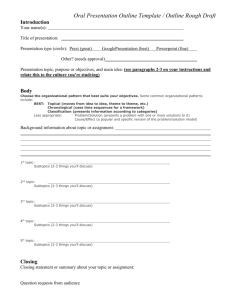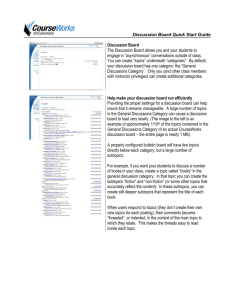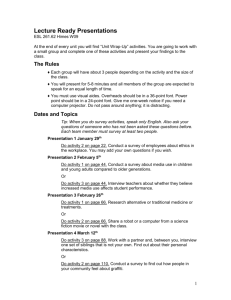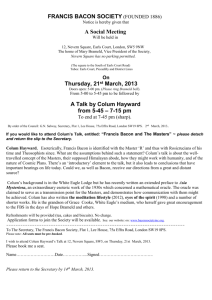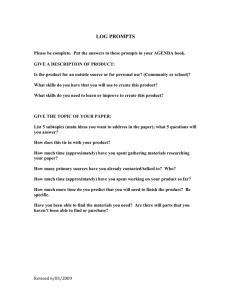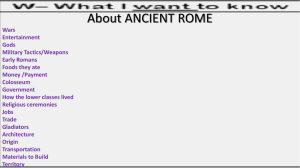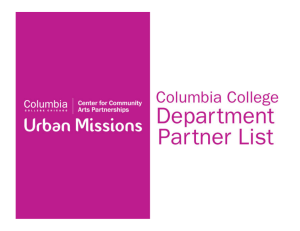How to concept map compositrev 5-2-2011
advertisement
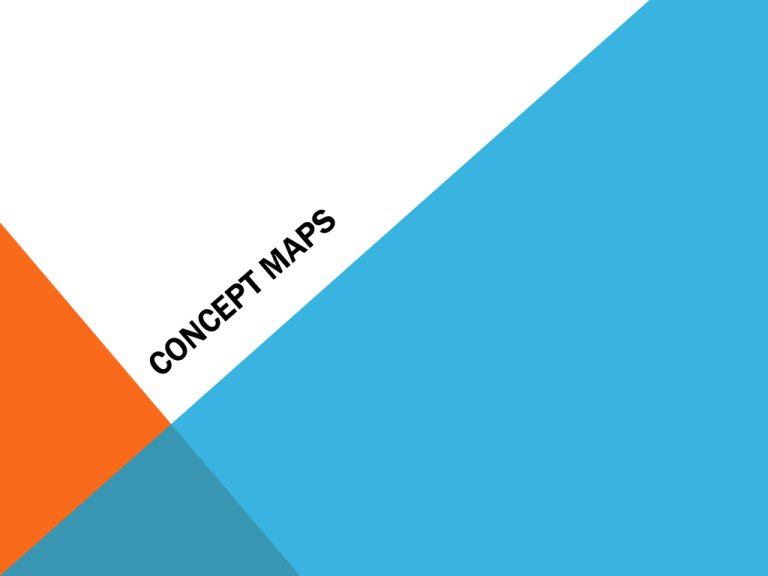
STUDENTS Often are challenged with Summarizing critical information, Describing concepts, and/or Organizing ideas in useful ways PURPOSES OF CONCEPT MAPPING • to generate ideas (brain storming, etc.) • to design a complex structure (long texts, hypermedia, large web sites, etc.) • to communicate complex ideas • to aid learning by explicitly integrating new and old knowledge • to assess understanding or diagnose misunderstanding CORBETT, 2004 HOW TO CREATE A CONCEPT MAP 1. Select text and choose/list key concepts 2. Organize concepts (hierarchy) 3. Construct map using rank-ordered concepts (usually need to “rework” maps) 4. Include valid links (propositions), cross-links, and examples (events or objects) 5. Evaluate USE CIRCLES OR OVALS TO ENCLOSE AN IMPORTANT TERM OR CONCEPT WITHIN THE TOPIC Each circle or oval should enclose only one term or concept. However, terms can be more than one word. CORBETT, 2004 CONCEPT MAPS VS. OUTLINES Concept maps: • LINK subordinate with superordinate showing relationship • show relationships VISUALLY • provide visual CROSS REFERENCING using cross links HOW DO I CREATE CONCEPT MAPS? Step 1 Start by placing your Main Idea in the center circle or graphic. Main Idea LAYOUT STAGE • Arrange terms so that they represent your collective understanding of the interrelationships and connections among groupings. • Use a consistent hierarchy in which the most important concepts are in the center or at the top. • Within sub-grouping, place closely related items near to each other. • Think in terms of connecting the items in a simple sentence that shows the relationship between them. • Feel free to rearrange things at any time during this phase. • Do not expect your layout to be like that of other groups. USE STRAIGHT LINES WITH ARROWS (SINGLE OR DOUBLE-HEADED) TO LINK TERMS THAT ARE RELATED • • • • Each line should link only two concepts. However, there is no limit to the number of links stemming from any one term. Pay close attention to the direction of the arrowheads on the linking lines when labeling them. Each concept is defined by its relation to other concepts within the topic. Relations include: superset, subset, attribute, part-whole. LINKING PHASE • Use lines with arrows to connect and show the relationship between connected items. • Write a word or short phrase by each arrow to specify the relationship. • Many arrows can originate or terminate on particularly important concepts. STEP 2 LOOKS LIKE THIS: Large topic Large topic Main Idea Large topic Large topic USE A WORD OR PHRASE OF WORDS AS LABELS ALONG THE LINES TO DESIGNATE THE RELATIONSHIP BETWEEN TWO CONNECTED TERMS • Each line should have a label that describes the relationship between the two terms it relationship connects. link relationship Example: link Important term feedback loop link Important term mutual relationship link Important term Important term mutual relationship link subtopics Large topic Large topic subtopics Main Idea Large topic Large topic subtopics subtopics REVISING STAGE • Carefully examine the draft concept map. • Rearrange sections to emphasize organization and appearance. • Remove or combine items to simplify. • Consider adding color or different fonts. • Discuss any aspects where opinions differ FINALIZING THE CONCEPT MAP • After your group has agreed on an arrangement of items that coveys your understanding, convert the concept map into a permanent form that others can view and discuss. • Be creative in a constructive way through the use of colors, fonts, shapes. WHAT IF I DON’T GET IT? • If you are having problems, try working in reverse. • Start with the most specific information and divide it into broader topics until you reach the center circle. • If you are still having problems, ask for assistance. 2 Colum Notes 2 COLUM NOTES Each student was required to use a notebook as their laboratory journal. The guideline for journal writing is double-entry: • Students use the right-hand side for constructing content knowledge, • The left-hand side for reflection on personal knowledge and recalling thoughts/feelings they had during the process of learning. Adapted from : Syh-Jong, J. (2007). A study of students’ construction of science knowledge: talk and writing in a collaborative group. Educational Research, 49(1), 65-81. doi: 10.1080/00131880701200781 2 COLUM NOTES • • • • Think actively about the topic Making connections and developing new insights When your section of the course is completed come together as a whole class to present findings. If there are disagreements about the findings or methods, intellectual autonomy rested with the students themselves, and students were required to negotiate their differences and work towards achieving a consensus. EACH WEEK • Each week you will be given a set of terms. You are to define the terms after completing the weeks activities. Write the formal explanation of the weeks terms in the right hand column and your interpretation/ questions/ discussion of the topic in the left side column. • The grade for this activity will be based on using all terms in the concept map accurately and by accurately defining all terms in the right hand side of the two Colum notes and by including your interpretation and connections in the left hand column. Your interpretations and questions Formal explanation WEEK 1 TERMS • • • • • • • • • • Relative dating Absolute dating Radioactive decay Half-life Law of superposition Law of original horizontality Crosscutting relationships Stratagraphic sequence correlation Faunal succession Geologic time
